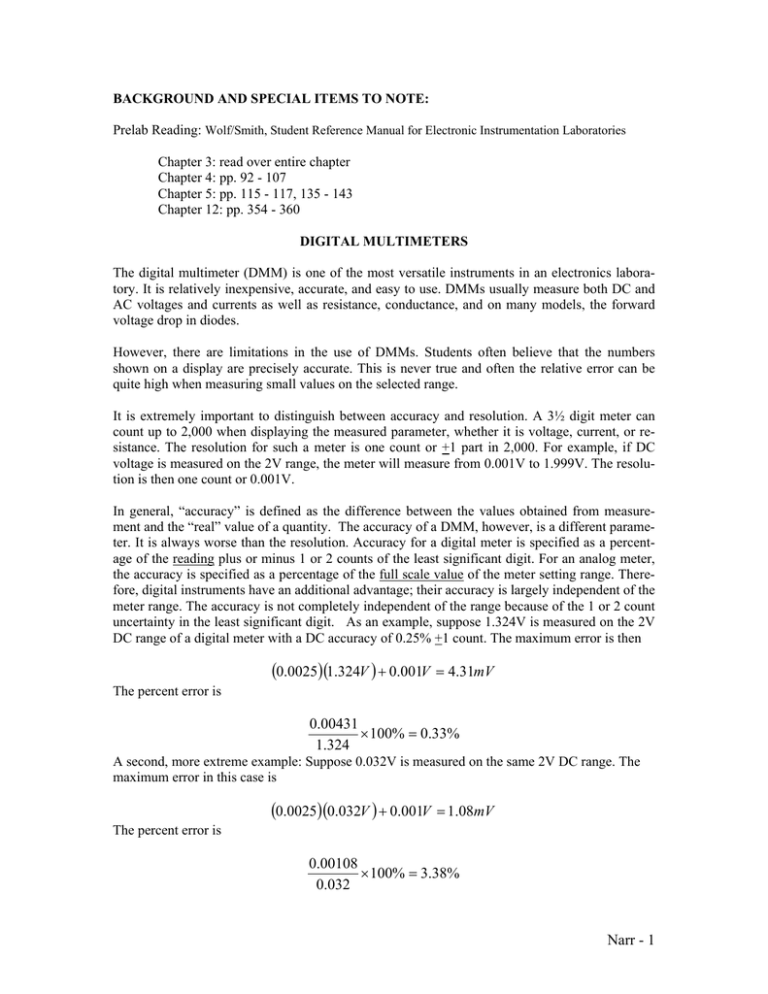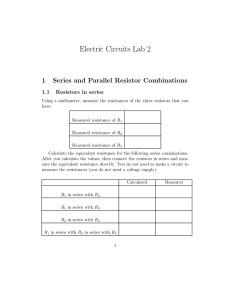DIGITAL MULTIMETERS
advertisement

BACKGROUND AND SPECIAL ITEMS TO NOTE: Prelab Reading: Wolf/Smith, Student Reference Manual for Electronic Instrumentation Laboratories Chapter 3: read over entire chapter Chapter 4: pp. 92 - 107 Chapter 5: pp. 115 - 117, 135 - 143 Chapter 12: pp. 354 - 360 DIGITAL MULTIMETERS The digital multimeter (DMM) is one of the most versatile instruments in an electronics laboratory. It is relatively inexpensive, accurate, and easy to use. DMMs usually measure both DC and AC voltages and currents as well as resistance, conductance, and on many models, the forward voltage drop in diodes. However, there are limitations in the use of DMMs. Students often believe that the numbers shown on a display are precisely accurate. This is never true and often the relative error can be quite high when measuring small values on the selected range. It is extremely important to distinguish between accuracy and resolution. A 3½ digit meter can count up to 2,000 when displaying the measured parameter, whether it is voltage, current, or resistance. The resolution for such a meter is one count or +1 part in 2,000. For example, if DC voltage is measured on the 2V range, the meter will measure from 0.001V to 1.999V. The resolution is then one count or 0.001V. In general, “accuracy” is defined as the difference between the values obtained from measurement and the “real” value of a quantity. The accuracy of a DMM, however, is a different parameter. It is always worse than the resolution. Accuracy for a digital meter is specified as a percentage of the reading plus or minus 1 or 2 counts of the least significant digit. For an analog meter, the accuracy is specified as a percentage of the full scale value of the meter setting range. Therefore, digital instruments have an additional advantage; their accuracy is largely independent of the meter range. The accuracy is not completely independent of the range because of the 1 or 2 count uncertainty in the least significant digit. As an example, suppose 1.324V is measured on the 2V DC range of a digital meter with a DC accuracy of 0.25% +1 count. The maximum error is then (0.0025)(1.324V ) + 0.001V = 4.31mV The percent error is 0.00431 × 100% = 0.33% 1.324 A second, more extreme example: Suppose 0.032V is measured on the same 2V DC range. The maximum error in this case is (0.0025)(0.032V ) + 0.001V = 1.08mV The percent error is 0.00108 × 100% = 3.38% 0.032 Narr - 1 This is less accurate than a good quality analog meter and much worse than the stated accuracy of the DMM. A solution to this problem is to switch to the next lowest scale, 200mV. The reading error would still be 0.25%, but the least significant digit uncertainty would be +0.1mV. Thus, the error for the 32mV reading is 0.56%. The conclusion is that to obtain the most accurate reading, one should always choose the lowest possible range. Other hidden sources of error in DMMs are noise, variations in temperature, and errors due to lack of calibration. The most accurate measurements that can be made with a DMM are DC voltages. All other measurements are less accurate, with AC current being the least accurate. When a single accuracy figure is given for a meter, it is always for DC voltage. Always read the complete specifications if measurements other than DC voltage are to be taken. Another item to keep in mind is that most DMMs measure the average value of AC signals. This value is then converted to the equivalent RMS value assuming the signal is a sine wave. Thus, for non-sinusoidal waveforms, the readings can be very inaccurate. Analog meters measure AC signals the same way. Some higher quality DMMs have a true RMS capability which allows for the computation of the actual RMS value. There are limitations to this technique. The crest factor (ratio of peak to RMS level) usually cannot be greater than about 5 to obtain accurate readings. The bandwidth of AC measurements is also quite limited. Most DMMs can measure AC voltages with their highest accuracy in the approximate range of 40Hz to 10kHz. Above 10kHz, most DMMs are unusable. Are analog meters obsolete? Almost. Their only advantage is that they can show trends. It is easier to see a needle move than it is to keep track of numbers changing on a display. To accommodate this feature, some digital instruments have an analog display in addition to the digital display. Analog meters find use in specialized measurement situations, such as high voltage, low current, or high resistance. Decade Resistance Boxes: Decade boxes provide a variable resistance which can be set by dials located on the face of the device. The dials represent resistances in multiples of consecutive powers of ten, which is the reason for the name decade box. The resistance value that you select on a decade box represents the nominal value. The nominal value of an electric component (e.g., a resistor, capacitor, etc.) represents the specific value that the manufacturer of that component intended to produce (typically in mass quantities). It is not necessary the same as its actual value or the value that you obtain using measuring instruments (such as a multimetr). The Multimeter: The multimeter derives its name from the fact that it can be used as an ohmmeter, ammeter, and voltmeter, though not simultaneously. It is capable of measuring resistance, current, and voltage. The multimeter is polarity sensitive for current and voltage measurements. In other words, the positive and negative terminals must be properly connected to obtain the correct reading. When taking a voltage or current measurement, you will be provided a desired polarity for the voltage or a direction for the current. For both cases, the positive lead of the multimeter is connected to the positive side of the element being measured. Resistance measurements are not polarity sensitive; the leads can be connected to the device in either polarity, although the results should be the same. Finally, extra care must be used when taking resistance measurements for two reasons: 1) if the resistor is in a circuit, it must somehow be isolated to prevent the measurement of a parallel combination with several other resistances in the circuit and 2) the circuit in which the device is connected must not be supplying voltage to the resistor while the measurement is being taken. In other words, the circuit must be dead (no external power supplied). Narr - 2 Taking Measurements with the Multimeter: Measurements should always be taken with meter leads. Though it is possible to take these measurements using other types of leads, appropriate equipment should be used to obtain accurate measurements. While taking measurements, never touch the circuit with your fingers, elbow, or tongue. If you are touching part of a live circuit, inaccurate measurements will result and it might also turn into a shocking experience of sorts. Multimeter Resolution: If the multimeter range is to be selected, choose the range that gives the most information. For example, if a 125Ω resistor is to be measured, the multimeter should be on the 200Ω scale to obtain maximum resolution. The resistance could be measured on a higher scale, but the display would not contain the same number of significant digits. This holds true for voltage, current, and resistance measurements. Loaded and Unloaded Voltage Measurements: There are basically two procedures when constructing a circuit. If a circuit requires 10V to be applied across two points in the circuit, the voltage source can be set to 10V then connected to the circuit, or the source can first be connected to the circuit then adjusted to 10V. You may be asking “what’s the difference?” For this experiment, there will be no noticeable difference, but it should be considered when dealing with higher source currents. When the procedure calls for a supply voltage set to a “loaded 10V,” set the voltage after the supply leads have been connected to the circuit. The Potentiometer: The potentiometer, or “pot” as it is more commonly referred to, is a three terminal variable resistance device. Pots come in various stated resistances, such as 100kΩ and 1MΩ. There is a constant resistance between the two outer terminals on this device. The center terminal is referred to as the “wiper” because it sweeps through the entire resistive element to provide variable resistance. Put another way, the wiper divides the resistance between the two outer terminals. The pot can be modeled as two resistors in series with the node between the two resistors being the wiper terminal. The circuit symbol for the pot is shown below. Narr - 3


